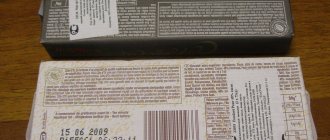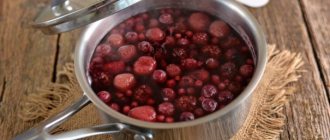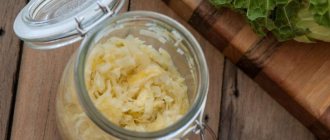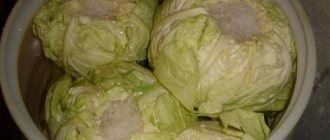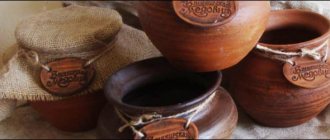Tips and facts
Which material is best for storing water?
This is such a simple question, it would seem. If you need to transport or store purified water, what is the best way to do this? Of course, if transportation takes 10 minutes, then the question posed in the title of this article is not worth a damn. But, if you need to store a supply of water, say, for a day?
So, let's not beat around the bush, but get straight to the point:
1. The best place to store water is in glass containers . Yes, ordinary glass is the least aggressive medium in principle; it does not react with water and does not spoil it in any way. The disadvantage of glass is its weight and fragility.
2. Stainless steel is the second best container for transporting and storing clean water. Stainless steel is an extremely low-chemically active alloy, so water in such containers does not acquire any odor or color in most cases (when using a high-quality alloy, of course). It’s not for nothing that expensive flasks use stainless steel alloys; moreover, such containers are not subject to accidental destruction due to impacts, pressure, or falls.
3. Aluminum alloy . Oddly enough, this is the most practical material. Despite the fact that water in aluminum containers acquires a distinct metallic taste, it does not have harmful properties. Aluminum is light and quite strong, aluminum flasks are extremely durable (it’s not for nothing that army units use aluminum flasks). But, over time, deposits may appear inside the aluminum container, which must be periodically removed by washing.
4. Well, in last place in terms of priority of use is plastic containers . This is a simple, accessible and cheap way to transport and store water. Light weight and ease of production made this container extremely popular.
However, it is useful to know that plastic (food grade) is also different, and not every container should be used. You can determine the suitability of the plastic by the marking (usually on the bottom) in the form of a triangle with arrows and a number inside (and an abbreviation below it). Security (from top to bottom):
| polypropylene | low density polyethylene |
| food containers, syringes, toys, shakers | bags (garbage), some containers |
| safely | relatively safe |
| polyethylene terephthalate | high density polyethylene | other types of plastic |
| water bottles, cosmetics, water bottles | disposable tableware, containers for cleaning products | water bottles, toys, packaging |
| practically safe | conditionally safe | usually safe |
| polyvinyl chloride | polystyrene |
| pipes, containers for technical fluids, furniture, etc. | trays, yogurt containers, sandwich panels |
| dangerous | dangerous |
That is, the safest containers are those with the number “5” (PP - polypropylene) and “4” (LDPE - low-density polyethylene). And the most dangerous (which should not be used in principle) are “3” (PVC or V - polyvinyl chloride, also known as technical plastic) and “6” (PS - polystyrene, not suitable for reuse in anything, as it emits a carcinogen in the form of styrene). And the most common type of plastic is “1” (PETE), almost 100% of water and lemonade bottles are made from it.
Well, to get clean water in our world, you need a filtration system. Without water purification, any container causes less harm to your body, rest assured of this.
2. Stainless steel is the second best container for transporting and storing clean water. Stainless steel is an extremely low-chemically active alloy, so water in such containers does not acquire any odor or color in most cases (when using a high-quality alloy, of course). It’s not for nothing that expensive flasks use stainless steel alloys; moreover, such containers are not subject to accidental destruction due to impacts, pressure, or falls.
Subtleties of drinking water storage
Everyone knows the saying “water is the basis of life.” It is especially relevant in our time, when tap water for drinking and domestic needs must be further purified. Some people install filtration systems in their homes, others buy purified water in special plastic bottles. This raises the question, how long can you store water in plastic, and is it possible at all?
Despite the fact that tap water undergoes multi-level purification using a variety of filters and chemicals, its quality and taste are far from the required standards.
Even after standing for a long time, tap water changes color, a green or rusty sediment and an unpleasant odor appear in it. Drinking such water is extremely dangerous.
How to store water to extend its shelf life?
Store water in a cool, dark place away from cleaning products, gasoline, paint thinner and other toxic or odorous materials. This is especially true now that bottles have become more environmentally friendly, and new materials have become lighter and thinner. To keep water fresh longer, store it in the refrigerator immediately after use.
Interesting facts about water:
- 40% of bottled water actually comes from the tap!
- To make a plastic bottle, it takes three times as much water as the bottle contains.
- It takes about 17 million barrels of oil per year to produce these plastic bottles alone. Therefore, use reusable water bottles whenever possible.
Never leave bottled water in direct sunlight or even in your car all day on a hot sunny day. The chemicals in the plastic container will heat up and leach into the water. Consumption of these bottles left in the sun is directly linked to breast cancer in women. And recent research shows a link with other types of cancer in both men and women.
How to store water
Let's return to the topic of storing water in plastic containers. Manufacturers of purified water claim that water is stored in such containers for a long time and safely. The bulk of water bottles are made from special food-grade plastic PET(E), which does not enter into chemical reactions with the contents of the bottle and therefore does not pose any threat to human health.
The label should be checked every time you purchase water; it should be stamped on the container. Sometimes, instead of safe markings, the abbreviation PVC is found. Such containers are made of potentially hazardous plastic, which is not intended for storing food products, including water.
Important! The PET(E) symbol on the bottle is a guarantee of the use of high-quality and safe plastic for its production.
The duration of storage of water in a sealed container is determined by its original quality and varies from six months to a year, so when choosing, you should carefully study the label for the bottling date.
The place where the water will be stored is also important. A corner without access to direct sunlight and a sufficient distance from devices that generate heat is best suited, since the temperature regime for storing water is 20-30 degrees. Water in open bottles can be stored for no more than a week.
To increase the shelf life of tap water, it should first be purified using a filter, then poured into a glass jar and allowed to stand for a while to get rid of chlorine vapors. Then cover with a tight lid and use within three days. This water will last a couple of days longer in the refrigerator.
Fans of boiling should remember that such water has no benefit, since heating to 100 degrees kills not only pathogens, but also beneficial bacteria.
This water should be kept in an enamel pan, covered with a tight lid, for no more than 12 hours. After this time, microbes from the environment begin to multiply in it, and boiled water can cause more harm than good.
Spring water and water from wells should be stored in glass or clay containers under a tight lid. Hermetically sealed, it can last from two to three years and not lose its beneficial properties. It is worth remembering that such water can only be collected from proven sources.
What determines the period of preservation of liquid properties and how does packaging affect this?
The period of time during which the liquid retains its properties in full directly depends on how carefully the rules for storing and transporting the goods were followed.
General technical information regarding drinking water packaged in containers is specified in GOST 32220-2013.
The duration of water storage is also affected by the container in which it was poured:
- Plastic packaging is the modern and most common option. In its manufacture, polyethylene terephthalate is used, a material that does not enter into chemical reactions with liquid.
- Glass containers are less convenient, but at the same time they are the safest material. Glass does not react with the contents of bottles even after long-term storage.
The period during which water poured into plastic containers retains its beneficial properties directly depends on the quality of the packaging used.
Liquid poured into glass containers has a longer shelf life, since glass practically does not react with other substances. Plastic, even intended for use in the food industry, over time begins to release substances hazardous to health.
Drinking bottled in bottles up to 19 liters
Bottled water has a shelf life of 3 to 24 months. After opening, its beneficial properties persist for 3-5 days. As a rule, the liquid is bottled in containers from 0.33 to 19 liters, and the volume does not affect the duration of its storage. This is true for both purified tap water and artesian water.
In accordance with the standards of GOST 32220-2013, section 11 - the shelf life of packaged water, starting from the date of its actual spill, is established by the manufacturer of the product based on the recommendations of national authorities exercising sanitary and epidemiological control and supervision.
Mineral, packaged in containers
Mineral water can also be stored in sealed bottles for 2 years; after opening the package, it can be consumed for the next 5 days if stored in the refrigerator at a temperature of +4 to 8 degrees Celsius.
What is structured water, how to obtain and store it
Today, structured water is quite popular, which is considered miraculous for the human body. The structure of water changes when frozen and heated. Most often it is stored frozen in glass containers.
At home, structured water can be obtained by freezing in several stages:
- To begin, filtered water is poured into an enamel container and sent to the freezer until a thin ice crust forms. After which this ice is removed and thrown away, since at temperatures from 0.28 to 3.8 degrees, the elements tritium and deuterium, which are harmful to health, freeze.
- Next, the water is left in the freezer until two-thirds of the volume freezes. Water that has not frozen is drained, along with the light elements and chemical additives remaining in it.
The ice that remains after all stages of freezing is structured water. It can be kept in the freezer and, if necessary, defrosted in portions. Or defrost all at once, pour into glass jars and store in the refrigerator. Many claim that storing structured water in silver dishes improves its properties several times.
Today, structured water is quite popular, which is considered miraculous for the human body. The structure of water changes when frozen and heated. Most often it is stored frozen in glass containers.
Bottled water. Terms and conditions of storage
Bottled water is intended for drinking and has different shelf life - from 3 to 24 months. It all depends on the purpose of the product, preservatives and the quality of the container.
Water itself does not spoil, as it contains preservatives. The reason for the deterioration in taste is plastic dishes. Over time, the material can release harmful chemicals and make the water unsafe to drink. Therefore, you should pay attention to the shelf life specified by the manufacturer. Be sure to check whether the product is certified or not. During storage, sudden changes in temperature should be avoided.
It is better to store hermetically sealed bottles out of direct sunlight, at a temperature of +5 to +20°C.
In unsealed containers, pathogenic bacteria can develop. For this reason, the water should be consumed within a week. It is better to use glass containers for storage, since glass does not release harmful chemicals into the water. It is also necessary to exclude exposure to ultraviolet rays. If stored incorrectly, a musty smell appears and sometimes a greenish sediment forms at the bottom of the bottle, so you can no longer drink such water.
How to select and store spring water
In the fight for quality of life and our health, in particular, we use all methods available to us. We boil tap water to soften it, filter it to make it suitable for drinking and cooking, add apple juice
In the fight for quality of life and our health, in particular, we use all methods available to us. We boil tap water to soften it, filter it to make it suitable for drinking and cooking, and add apple cider vinegar or lemon juice to prevent hard tap water from harming our skin and hair.
Tap water is always chlorinated, various additives and additives are added to it, which makes it harmful for use. If you really care about your health, then such water is not suitable, except for washing clothes and cleaning the apartment.
If you have ever tasted water from a spring in your life, you probably remember its taste, this is the kind of water that will give the body the energy of nature, this water is alive, it is saturated with oxygen.
Riens › Blog › How long does water last?
As the season approaches, I look at the “paranoid nest” more and more often, and sometimes I find interesting things there. It would seem that such a banal thing as the delivery and storage of water, in the practice of a field AHCh specialist, sometimes turns into wild difficulties. I myself saw how they gave antifreeze canisters for drinking water, how they drank chemically and thermally unpurified water, then suffering from stomach pain, although there was always a fire burning in the camp and there was always at least a kettle or a boiler available. And other extremes, when people even washed their hands only with water from mineral water bottles. Actually, copy-paste from a well-known resource in narrow circles. Let's hope they won't be offended


